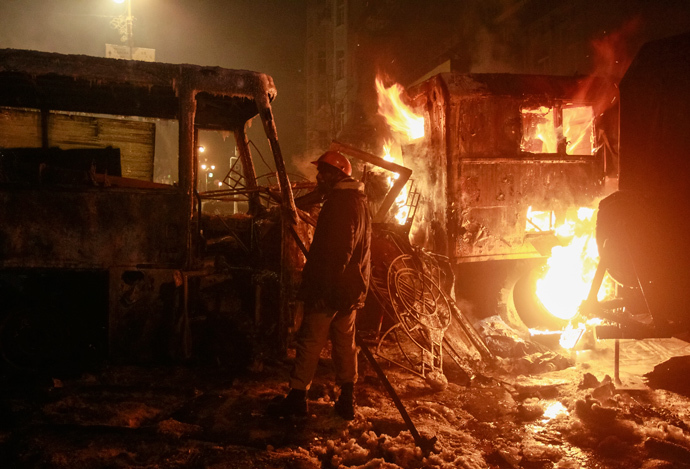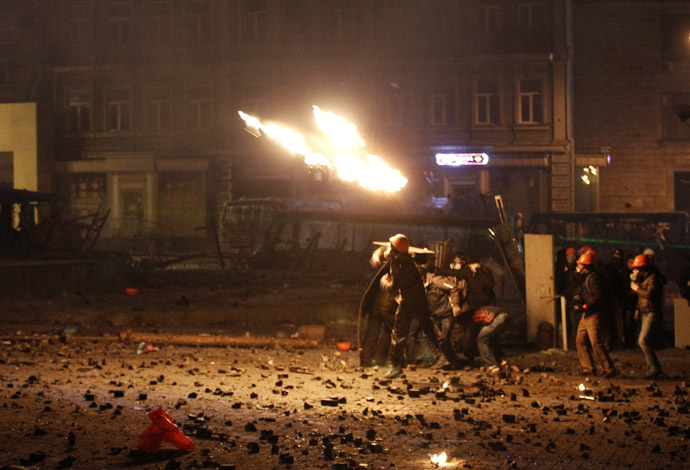Combat zone Kiev: Police move to force rioters off streets (PHOTOS)
Tension remains high in Kiev, as rioting radicals and Ukraine’s riot police continue their stand-off in the center of the town. Over two hundred people have been injured in scuffles, half of them law officers hurt by rocks and Molotov cocktails.
Follow RT's live updates.
The stand-off in the Ukrainian capital is continuing into its third day in Hrushevsky Street, a small area in the vicinity of the national Parliament building, which is the focus of anti-government rioting.
“We have seen Molotov cocktails being thrown at the police, firecrackers, small bombs exploding from time to time. It is still definitely a hotbed of tension,” RT’s Aleksey Yaroshevsky reported from the scene.
There were about 200 to 400 rioters remaining overnight, with barely dozens of them continuing their attacks on the police cordon. Riot police held their line, sporadically firing rubber bullets and throwing stun grenades at the most blatant protesters.

The police took over and destroyed an improvised catapult, which the protesters built to throw rocks, but which proved to be rather inefficient. They also dismantled one of the barricades erected by the radicals. By Tuesday morning they had retreated back to their position.
By mid-Tuesday the opposition crowd had become more numerous, with about 1,000 people attending. But direct attacks on police stopped, with protesters simply shouting slogans and banging on barrels and metal remains of police buses, which had been torched by the rioters previously.
City authorities estimated that the mass protests in Kiev would cost the city at least $1.75 million over two months. The figure, however, does not include the damages from the two days of rioting. It may be significant, considering that the radical opposition activists virtually destroyed the street’s tile pavement, ripping it up to make projectiles to throw at police.
Protesters lining up preparing for a possible assault by the police pic.twitter.com/QU0HoD9Si1
— Alexey Yaroshevsky (@Yaro_RT) January 20, 2014
The number of protesters injured in recent clashes in Kiev reached 122 on Tuesday and 50 still remain in hospitals, city authorities reported. It comes after six more protesters from Hrushevsky Street sought medical help, including five, who have been hospitalized.
Meanwhile, the Interior Ministry gave its casualty report on Tuesday, saying that 163 officers have been injured in total since the rioting started. Of them 80 had to be admitted to hospital.
The policemen suffered head injuries, fractures, burns, stab and slash wounds, as well as poisoning by “unknown substances,” the report said.
The ministry said they detained 32 radical activists during the riot, with 22 of them remaining in police custody. Of those, at least 13 are to be charged with various crimes.

As the scuffles continued on Monday night, police warned that they may authorize the use of live ammunition, if violence starts spreading out of control.
The warning came amid speculation in the social media, which claimed that the radical protesters will soon be joined by thousands of like-minded activists. The rumors said the reinforcements may come from other countries, where radical football fans are rallying to go to Ukraine and join the confrontation. So far no evidence of those groups has been reported.

Elsewhere in Kiev’s Independence Square, protesters reported seeing “groups of men in sports uniforms carrying baseball bats and chains surrounding the area,” Yaroshevsky reported.
The less-radical opposition groups in the square labeled them as government-paid thugs, which were brought into the city to spread rioting and discredit the protest.
Among those pressing such allegations is one of the opposition leaders, Vitaly Klitschko, who has urged the avoidance of violence.
At the same time he called on all Ukrainians to travel to Kiev and fight for the country’s future in what he described as the government’s war on its people.
Klitschko’s anti-violence calls may come too late for the Maidan activists. The Ukrainian Interior Ministry accused them on Monday of arming rioters with improvised spears and other weapons. The ministry said opposition MPs were among those handing out the weapons and encouraging violence.

The Ukrainian opposition is out of control and is clearly seeking to overthrow the government through violence, the foreign affairs editor from Chronicles Magazine, Srdja Trifkovic, told RT.
“Now we are dealing with a significant group of highly committed people hell-bent on regime change through street thuggery,” he told RT. “What we are dealing with is a clear attempt to undermine the constitutional order of a major European state and it is truly shocking for a European parliamentarian to say that they are still supportive of a process that wants to use street violence and mob rule as the means of regime change.”
Kiev experienced one of worst instances of rioting in its modern history over the past two days. On Monday, protesters from radical nationalist groups climbed on to the main gate of the Dynamo football stadium at Hrushevsky Street, using it as a vantage point to bombard riot police with Molotov cocktails.
The police opted for tear gas and stun grenades in order to contain the rioting crowd, which local media estimated at around 2,000.
RT’s cameraman was caught in the stand-off when he was hit in the back with a rubber bullet fired by police, Yaroshevsky reported. The cameraman was not injured.

The clashes erupted after a massive rally held in Independence Square on Sunday, where protesters spoke out against new laws adopted by the Ukrainian government last week.
The legislation toughens restrictions on mass protests, access to certain websites on the internet and introduces criminal punishment for libel and defamation of officials.

The situation in Ukraine has been tense since November 21, when the authorities suspended preparations for signing an association agreement with the EU.















